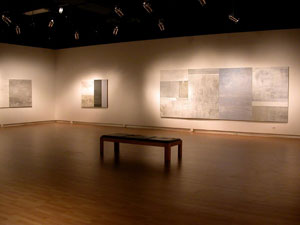ntering Brenton Good’s MFA-qualifying exhibition titled [departure] at the Fort Worth Community Arts Center is like submerging oneself…
Entering Brenton Good’s MFA-qualifying exhibition titled [departure] at the Fort Worth Community Arts Center is like submerging oneself in a subtly-textured ocean of muted colors and layered surfaces. His monotypes, fusions of printmaking and painting, absorb the viewer in rich, abstract detail. A recent graduate of the University of Dallas, Good explores the formal and humanistic depths of composition and color.
Although he uses traditional printmaking tools – stamps and brayers – Good also borrows heavily from painting. Rather than produce multiple editions of his prints, he makes monotypes, which retain an aura of uniqueness. Assembling his monotypes in groups of large, abutting panels, Good alludes to two major painting traditions: Western devotional triptychs and Eastern shoji screens, both of which traditionally attract reverent reflection.
Good’s painterly prints dwarf the viewer, evoking the overwhelming scale of Abstract Expressionism and offering a landscape of marks and patterns. In his stripes and scoring, stains and splotches, order converses with chaos, with crisp geometric grid systems that are repeated in the arrangement of the panels themselves. In response are what appear to be accidental occurrences (water stains, amorphous drips, haphazard scratches). Each mark and each panel, like individual structural supports in a building, operate both on their own as well as in conjunction with the larger whole.
Good’s color spectrum -blues, grays, rusty reds, greens, muddied creams—helps develop the architectonics of his compositions. The exchange of color in Good’s prints is reminiscent of Josef Albers’s or Brice Marden’s explorations into color combinations and their resulting visual effects. But instead of focusing on flat areas of hues, Good experiments with opacity and translucency. Applying as many as forty layers of color in each work, he meticulously labors over the dynamics of his palette. Surfaces upon surfaces become increasingly apparent upon prolonged viewing, as the abstractions evoke contemplative responses. Like a sci-fi or fantasy story, Good’s passages vault the viewer into a complex existence of balances and structures, form and chaos. His infinitesimal degree of subtleties—in opacity and transparency, geometry and organicity, line and color – create a push and pull of formal elements, which describe both micro—and macrocosms.
These compositional devices, though fundamentally non-representational, curiously allude to such mundanely beautiful things as cracked concrete surfaces, coffee stains, and oily puddles. The titles also provide a more personal access to the works, with such open-ended and evocative references as “condolence” and “upon parting.” The intricate visual systems and suggestive titles allow more personal interpretations of inherently abstract pictorial elements. The experiential quality of Good’s monotypes adds to the vitality of his compositions, which seem to act and react not only to internal formal elements, but also with the viewer’s subjective awareness. According to Good, “each layer of color becomes a record of a decision made concerning composition, weight, or rhythm.”[1.] The visitors reflecting upon and experiencing Good’s exhibition represent yet another, though ephemeral, layer to the prints’ histories.
Good’s monotypes demonstrate masterful evolutions of formal elements, which envelop the viewer in nuances of abstraction. His compositional systems pivot on dualities: printmaking and painting, human control and organic intervention, and formal and humanistic relations. Through this interchange, Good creates works that address broad audiences, yet also provoke more personal reflections.




